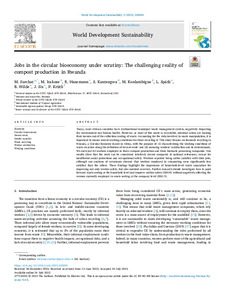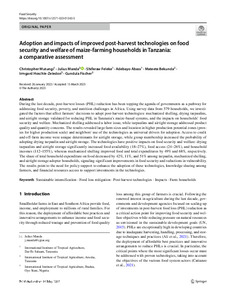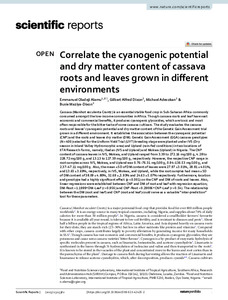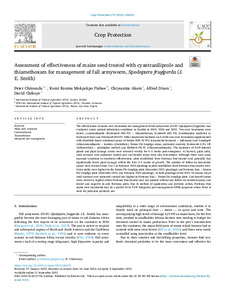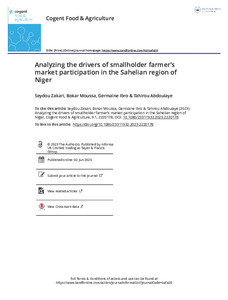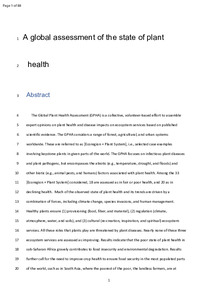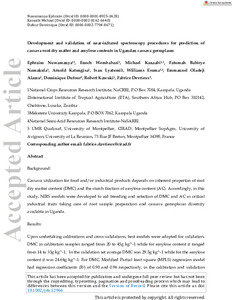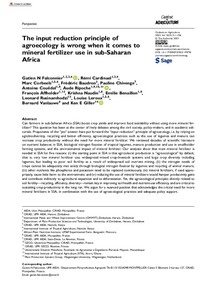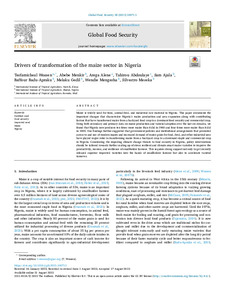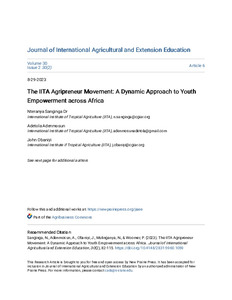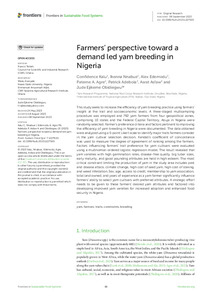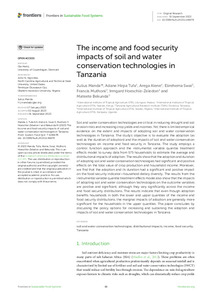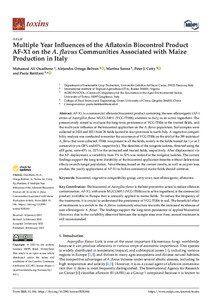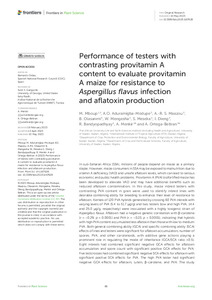Welcome to the International Institute of Tropical Agriculture Research Repository
Journal and Journal Articles: Recent submissions
Now showing items 241-260 of 5283
-
Jobs in the circular bioeconomy under scrutiny: the challenging reality of compost production in Rwanda
(2023-12)Today, most African countries have dysfunctional municipal waste management system, negatively impacting the environment and human health. However, as most of this waste is recyclable, informal actors are making their income out of the collection/sorting of waste. Accounting for the risks involved in waste manipulation, it is important to ensure decent working conditions for those recycling it. This study focuses on biowaste recycling in Rwanda, a Circular Economy leader in Africa, with the purpose ... -
Adoption and impacts of improved post-harvest technologies on food security and welfare of maize-farming households in Tanzania: a comparative assessment
(2023-05-16)During the last decade, post-harvest losses (PHL) reduction has been topping the agenda of governments as a pathway for addressing food security, poverty, and nutrition challenges in Africa. Using survey data from 579 households, we investigated the factors that affect farmers’ decisions to adopt post-harvest technologies: mechanized shelling, drying tarpaulins, and airtight storage validated for reducing PHL in Tanzania’s maize-based systems, and the impacts on households’ food security and ... -
Development of an improved steamer for optimum retention of carotenoids in Attieke produced from biofortified cassava (Manihot esculenta Crantz) roots
(2023)Attiéké, made from biofortified (yellow) cassava genotypes, requires a new cooking method to minimize carotenoid degradation during processing. Thus, this research is aimed at designing and building a more efficient steamer to produce high-quality attiéké from biofortified cassava roots. Using three improved biofortified cassava genotypes (IBA141092, IBA070593, and IBA011368) obtained from IITA research farms, attiéké samples were produced using traditional and developed steamers. The results show ... -
Habitat range shift and prediction of the potential future distribution of Ricinodendron heudelotii (Baill.) Heckel in Benin (West Africa)
(2023)Ricinodendron heudelotii (Baill.) Heckel is an important nutraceutical reservoir. Its Sustainable exploitation requires information on its potential distribution in the current context of rapid population growth and climate change threats. This study aimed to map the suitable areas for its domestication and conservation under current and future climate conditions in Benin. Occurrence data were recorded and combined with the environmental layers of two climatic scenarios (optimistic RCP 4.5 and ... -
Correlate the cyanogenic potential and dry matter content of cassava roots and leaves grown in different environments
(2023)Cassava (Manihot esculenta Crantz) is an essential stable food crop in Sub-Saharan Africa commonly consumed amongst the low-income communities in Africa. Though cassava roots and leaf have vast economic and commercial benefits, it produces cyanogenic glycosides, which are toxic and most often responsible for the bitter taste of some cassava cultivars. The study evaluates the cassava roots and leaves’ cyanogenic potential and dry matter content of the Genetic Gain Assessment trial grown in a different ... -
Effects of traditional preparatory techniques on the chemical and pasting characteristics of yellow-fleshed cassava roots (Manihot esculenta)
(2023)Understanding the interactions between chemical and pasting properties and conventional cooking methods will help utilise yellow-fleshed cassava roots. Thus, the study examined how conventional processing affected Nigerian yellow-fleshed cassava's chemical and pasting properties. Three improved, yellow-fleshed genotypes were harvested 12 months after planting: 01/1371 (high carotenoids, 7.3 μg/g on Fresh weight basis (FW)), 01/1235 (medium, 4.8 μg/g FW), and 94/0006 (low, 2.6 μg/g FW). The peeled ... -
Assessment of effectiveness of maize seed treated with cyantraniliprole and thiamethoxam for management of fall armyworm, Spodoptera frugiperda (J. E. Smith)
(2023-12)The effectiveness of maize seed treatments for management of fall armyworm (FAW) (Spodoptera frugiperda) was evaluated under natural infestation conditions in Zambia in 2019, 2020 and 2022. Two seed treatments were tested: cyantraniliprole (Fortenza® 600 FS) + thiamethoxam (Cruiser® 600 FS) (combination marketed as Fortenza® Duo) and Fortenza® 600 FS. Other treatments included each of the two seed treatments supplemented with threshold-based rotational sprays of Denim Fit® 50 WG (emamectin benzoate ... -
Drivers of consumer acceptability of cassava gari-eba food products across cultural and environmental settings using the triadic comparison of technologies approach (tricot)
(2023-07-18)BACKGROUND Nigeria and Cameroon are multi-ethnic countries with diverse preferences for food characteristics. The present study aimed to inform cassava breeders on consumer-prioritized eba quality traits. Consumer testing was carried out using the triadic comparison of technologies (tricot). Diverse consumers in villages, towns and cities evaluated the overall acceptability of eba made from different cassava genotypes. Data from both countries were combined and linked to laboratory analyses of eba ... -
Analyzing the drivers of smallholder farmer’s market participation in the Sahelian region of Niger
(2023-06-02)Many sub-Saharan farmers rely on agricultural production for home consumption and sell crops to meet their other needs. Farmers’ market intervention enhances economic expansion and helps to improve household food security. In our current study, we strive to explore the determinants of farmers’ decisions and the intensity of market participation in the Sahelian region of Niger, where little has been published, thereby filling the gap in the literature. A double hurdle approach was employed to achieve ... -
A global assessment of the state of plant health
(2023)The Global Plant Health Assessment (GPHA) is a collective, volunteer-based effort to assemble expert opinions on plant health and disease impacts on ecosystem services based on published scientific evidence. The GPHA considers a range of forest, agricultural, and urban systems worldwide. These are referred to as [Ecoregion × Plant System], i.e., selected case examples involving keystone plants in given parts of the world. The GPHA focuses on infectious plant diseases and plant pathogens, but ... -
Development and validation of near-infrared spectroscopy procedures for prediction of cassava root dry matter and amylose contents in Ugandan cassava germplasm
(2023-09-04)Background Cassava utilization for food and/or industrial products depends on inherent properties of root dry matter content (DMC) and the starch fraction of amylose content (AC). Accordingly, in this study, NIRS models were developed to aid breeding and selection of DMC and AC as critical industrial traits taking care of root sample preparation and cassava germplasm diversity available in Uganda. Results Upon undertaking calibrations and cross-validations, best models were adopted for validation. ... -
The input reduction principle of agroecology is wrong when it comes to mineral fertilizer use in sub-Saharan Africa
(2023-09)Can farmers in sub-Saharan Africa (SSA) boost crop yields and improve food availability without using more mineral fertilizer? This question has been at the center of lively debates among the civil society, policy-makers, and in academic editorials. Proponents of the “yes” answer have put forward the “input reduction” principle of agroecology, i.e. by relying on agrobiodiversity, recycling and better efficiency, agroecological practices such as the use of legumes and manure can increase crop ... -
Assessing the impact of Gliricidia agroforestry-based interventions on crop nutritional, antinutritional, functional, and mineral compositions in eastern Province, Zambia
(2023-09-10)Agroforestry practices improve soil health which in turn improves crop nutrient concentrations and quality. This study examined how the agroforestry tree Gliricidia sepium intercropped with soybean, groundnuts, or maize affects crop nutrient compositions. The study was conducted in five Zambian chiefdoms for three crop-growing seasons (2019–2022) on 13 farmer-led demonstration trial sites. Seven treatments were tested that included maize, soybean, and groundnut plots with and without Gliricidia ... -
Drivers of transformation of the maize sector in Nigeria
(2023-09)Maize is widely used for food, animal feed, and industrial raw material in Nigeria. This paper documents the important changes that characterize Nigeria’s maize production and area expansion along with contributing factors that have transformed maize from a backyard food crop to a dominant food security and commercial crop. Using both secondary and primary data on maize production and varietal adoption over the last six decades, we found that Nigeria now produces ten times more maize than it did ... -
The IITA agripreneur movement: a dynamic approach to youth empowerment across Africa
(2023-08-29)The Agripreneur Movement of the International Institute of Tropical Agriculture (IITA) allows youth to assume their rightful place in African agricultural transformation. It started as a single exploratory agribusiness incubation at IITA Headquarters in 2012, involving 37 youths. It has since grown to 10 countries through nine sponsoring organizations. We compiled the characteristics and outcomes of 40 Agripreneur projects between 2012 and 2021 to describe the movement’s growth. With time, the ... -
Farmers’ perspective toward a demand led yam breeding in Nigeria
(2023-09-08)This study seeks to increase the efficiency of yam breeding practice using farmers’ insight at the trait and socioeconomic levels. A three-staged multisampling procedure was employed and 792 yam farmers from four geopolitical zones, comprising 10 states and the Federal Capital Territory, Abuja in Nigeria were randomly selected. Farmer’s preference criteria and factors pertinent to improving the efficiency of yam breeding in Nigeria were documented. The data obtained were analyzed using a 5-point ... -
The income and food security impacts of soil and water conservation technologies in Tanzania
(2023-09-01)Soil and water conservation technologies are critical in reducing drought and soil erosion risks and increasing crop yields and incomes. Yet, there is limited empirical evidence on the extent and impacts of adopting soil and water conservation technologies in Tanzania. The study’s objective is to evaluate the adoption (as well as the duration of adoption) and the impacts of soil and water conservation technologies on income and food security in Tanzania. The study employs a control function approach ... -
Multiple year influences of the aflatoxin biocontrol product AF-X1 on the A. flavus communities associated with maize production in Italy
(2023-02-28)AF-X1 is a commercial aflatoxin biocontrol product containing the non-aflatoxigenic (AF-) strain of Aspergillus flavus MUCL54911 (VCG IT006), endemic to Italy, as an active ingredient. The present study aimed to evaluate the long-term persistence of VCG IT006 in the treated fields, and the multi-year influence of the biocontrol application on the A. flavus population. Soil samples were collected in 2020 and 2021 from 28 fields located in four provinces in north Italy. A vegetative compatibility ... -
Uneven ground? Intersectional gender inequalities in the commercialized cassava seed system in Tanzania
(2023-10-02)Cassava (Manihot esculenta Crantz) is an important crop in Africa, especially to women who rely on it as a household staple food and source of income. In Tanzania, a recent move toward commercializing the cassava seed system resulted in significantly fewer women than men farmers, known as Cassava Seed Entrepreneurs (CSEs), producing improved seed for sale to fellow farmers. To document the barriers and constraints that create gender inequalities in the seed system to better understand women’s low ... -
Performance of testers with contrasting provitamin A content to evaluate provitamin A maize for resistance to Aspergillus flavus infection and aflatoxin production
(2023-05-10)In sub-Saharan Africa (SSA), millions of people depend on maize as a primary staple. However, maize consumers in SSA may be exposed to malnutrition due to vitamin A deficiency (VAD) and unsafe aflatoxin levels, which can lead to serious economic and public health problems. Provitamin A (PVA) biofortified maize has been developed to alleviate VAD and may have additional benefits such as reduced aflatoxin contamination. In this study, maize inbred testers with contrasting PVA content in grain were ...

